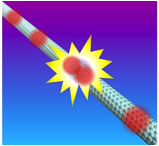George Pólya, the Hungarian mathematician, told a story about taking a walk and meeting the same couple over and over again. He became embarrassed about appearing to spy on them, but it got him thinking about the likelihood of repeated meetings between objects moving at random. In 1921 he published his famous recurrence theorem*, which concluded that walkers moving randomly in 2 dimensions or less would definitely meet, whereas in 3 dimensions or more they might never encounter each other. Or as Shizuo Kakutani put it, “a drunk man will find his way home, but a drunk bird may get lost forever.”
If the random walkers are molecules that react when they meet, the rate of reaction also depends on the dimensionality of the space in which they move. Imagine two drunks walking at random up and down a tightrope: they will definitely collide, whereupon at least one of them is likely to fall off. If there are many drunks involved,then after a while the survivors find themselves spaced rather regularly. This is a simple example of collective effects in systems of interacting particles that never reach equilibrium: such behaviour occurs widely in nature but a full understanding is considered one of the “grand challenges” of contemporary physics. Experiments haven’t helped much: they are notoriously challenging and results are rare.
In this week’s issue of Physical Review Letters+, we publish experimental results on simple reactions in an ideal one-dimensional system, where the ‘molecules’ are excitons (made up of a negatively-charged electron and a positive ‘hole’) moving along carbon nanotubes. We show how the reaction rate is determined both by the time it takes for excitons to first meet each other and by the duration of their encounter, confirming a theoretical prediction made almost 30 years ago. This process is not restricted to carbon nanotubes: for example, it is thought to explain the mechanism that triggers DNA replication in cells, where proteins move and react on the DNA strands.
Carbon nanotubes are considered interesting for their technological applications, but here they are a vehicle for fundamental science. For physicists, this close relation between basic science and applications is one of the things that makes nanotechnology such a rewarding field to play work in.
*With the catchy title of “Über eine aufgabe der wahrscheinlichkeitsrechnung betreffend die irrfahrt im Straßennetz”.
+Measurement of a reaction-diffusion crossover in exciton-exciton recombination inside carbonnanotubes using femtosecond optical absorption, J. Allam, M. T. Sajjad, R. Sutton, K. Litvinenko, Z. Wang, S. Siddique, Q.-H. Yang, W. H. Loh, and T. Brown, Phys. Rev. Lett. 111, 197401 (2013).

